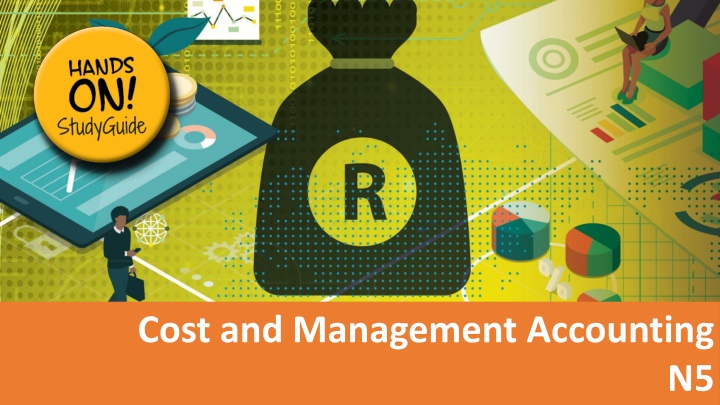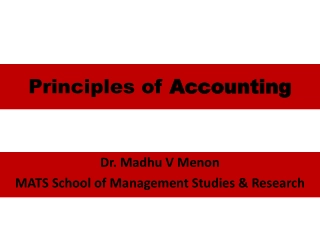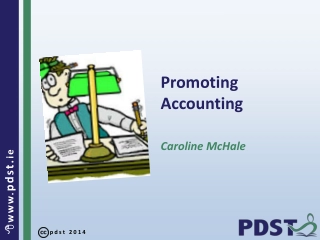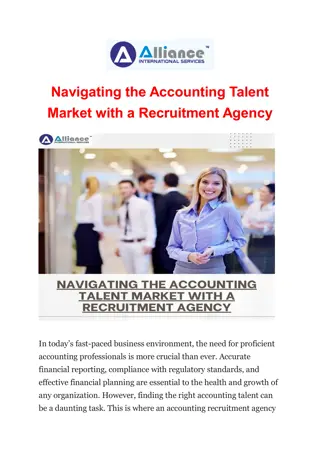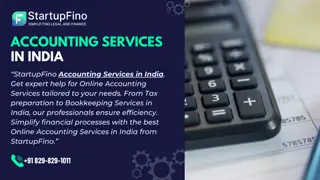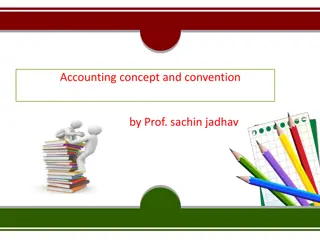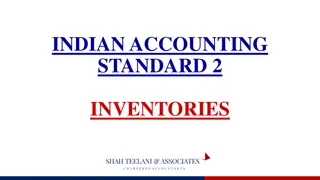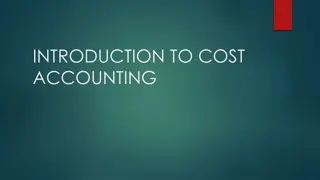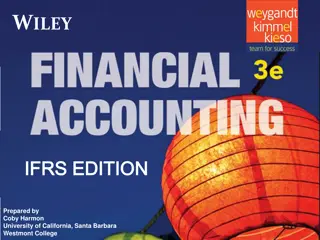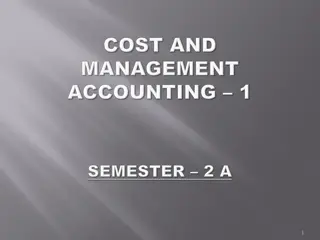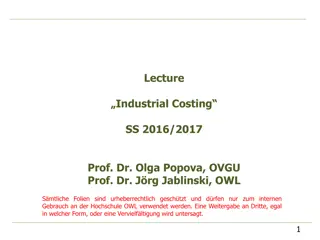Cost and Management Accounting - Field Overview
In the field of accounting, various specializations exist such as cost accounting, managerial accounting, and financial accounting. This module delves into the concepts related to cost accounting including cost classification, management functions, cost systems, unit costs, fixed costs, and variable costs.
Download Presentation

Please find below an Image/Link to download the presentation.
The content on the website is provided AS IS for your information and personal use only. It may not be sold, licensed, or shared on other websites without obtaining consent from the author.If you encounter any issues during the download, it is possible that the publisher has removed the file from their server.
You are allowed to download the files provided on this website for personal or commercial use, subject to the condition that they are used lawfully. All files are the property of their respective owners.
The content on the website is provided AS IS for your information and personal use only. It may not be sold, licensed, or shared on other websites without obtaining consent from the author.
E N D
Presentation Transcript
Module 1 Cost: Concepts and objectives THE DIFFERENT FIELDS OF ACCOUNTING The different fields of accounting are: Cost accounting; Managerial accounting; and Financial accounting. www.futuremanagers.com
Module 1 Cost: Concepts and objectives (continued) MANAGEMENT FUNCTIONS Management functions are often grouped as follows: Planning; Organising and directing; Controlling; Decision making. www.futuremanagers.com
Module 1 Cost: Concepts and objectives (continued) COST CLASSIFICATION Cost is the sacrifice of resources, measured in monetary terms, to obtain goods or services. Costs can be collected accordingly to the following methods: Functions Departments Elements Income Product Volume. www.futuremanagers.com
Module 1 Cost: Concepts and objectives (continued) COST SYSTEMS Cost systems are the methods used by businesses to collect, process and evaluate all the information in connection with the cost of a product or service. The purpose of a cost system is to provide information to management about costs incurred. www.futuremanagers.com
Module 1 Cost: Concepts and objectives (continued) UNIT COSTS A unit cost is simply the cost of one unit produced. The total production cost is divided by the number of units produced. www.futuremanagers.com
Module 1 Cost: Concepts and objectives (continued) FIXED COST Fixed cost stays the same, irrespective of the number of units produced. The fixed cost per unit will decrease if the volume of production increases and vice versa. www.futuremanagers.com
Module 1 Cost: Concepts and objectives (continued) VARIABLE COST The total variable cost changes in direct proportion to the change in level of production. The variable cost per unit, on the other hand, is the same. www.futuremanagers.com
Module 1 Cost: Concepts and objectives (continued) OTHER COST TERMS Period cost; Opportunity cost; Avoidable cost and unavoidable cost; Sunk cost; Controllable and non-controllable cost; Relevant cost. www.futuremanagers.com
Module 2 Material INTRODUCTION Production is the conversion of direct material into finished goods by direct labour and manufacturing overheads, normally also using factory equipment in the process. The production process begins with the transfer of raw materials from the storeroom to the factory or production line. www.futuremanagers.com
Module 2 Material (continued) TERMINOLOGY Direct/raw/primary material; Indirect/secondary material; Incomplete work or work in production/progress/process; Finished products/finished goods; and Consumable stores. www.futuremanagers.com
Module 2 Material (continued) STOCK PROCEDURES Stock procedures include: Purchase; Receipts; Stock keeping; Storage; Issue; Valuation. www.futuremanagers.com
Module 2 Material (continued) RECEIPT AND STOCK KEEPING Once the delivery takes place, the material must be checked against the packing slip or invoice accompanying the delivery, as well as against the original order. A goods received voucher is completed and the material entered on the computer or the stock list. www.futuremanagers.com
Module 2 Material (continued) STORAGE/WAREHOUSING The following factors regarding the layout or organisation of the store/ warehouse must be considered: Enough space and proper control measures must be in place. For security reasons there must be a minimum number of entry points. Stock issued regularly must be stored near an exit point. There should be aisles for forklifts and other transporting equipment. Perishables must be stored under special conditions. www.futuremanagers.com
Module 2 Material (continued) ISSUE OF STOCK Proper control over issuing of material and stock is of the utmost importance. Without strict control measures, the business can lose thousands of Rands worth of stock. www.futuremanagers.com
Module 2 Material (continued) STOCK VALUATION Different methods can be used for the valuation of stock on hand. It is important that the business choses one method and sticks to that method. These are: FIFO method, Weighted-average method; LIFI method; Standard price method; Market price method. www.futuremanagers.com
Module 2 Material (continued) THE FLOW OF MATERIAL (AND THE RECORDING OF THE TRANSACTION) www.futuremanagers.com
Module 2 Material (continued) ACCOUNTING ENTRIES: MATERIAL When material is purchased, the cost price is recorded in the Material Control account. Material is stock, therefore it is an asset with a debit balance. The quantity and unit cost of each purchase are entered on material stock cards. One card is maintained for each type of material. These cards function as a subsidiary ledger supporting the Material Control account. The totals of the stock cards must correspond with the entries in the Material Control account. www.futuremanagers.com
Module 3 Labour INTRODUCTION Labour requires more involvement from management than the other cost components, material and factory overheads owing to the fact that it involves other people, which can add in a layer of complication. www.futuremanagers.com
Module 3 Labour (continued) LABOUR COST For accounting purposes, the wages cost must be split up into direct wages, indirect wages and non-manufacturing wages: Normal time + Overtime + Bonus = Gross Wage Gross Wage Deductions = Net Wage Gross Wage + Employer s Contributions = Total Wages Cost www.futuremanagers.com
Module 3 Labour (continued) WAGE CONTROL To effectively control labour costs, management needs accurate, timely information. This is obtained by using staff records, clock cards/timecards and job cards and, among others, compiling a payroll to calculate net wages and salaries www.futuremanagers.com
Module 3 Labour (continued) ACCOUNTING ENTRIES: LABOUR Debit the Labour Control account with the total expense as regards wages. Credit Creditors for wages with the net wages. Credit South African Revenue Services with the amount deducted from salaries. Credit Pension Fund with amount deducted from workers and employer s contribution. www.futuremanagers.com
Module 4 Manufacturing overheads INTRODUCTION Manufacturing overheads can be defined very simply as including all manufacturing costs except direct material and direct labour. Manufacturing overheads are indirect cost. www.futuremanagers.com
Module 4 Manufacturing overheads (continued) CLASSIFICATION OF MANUFACTURING OVERHEADS Fixed manufacturing overheads do not change in total as business activity increases or decreases. A variable overhead cost increases in total in proportion to the activity level and decreases proportionally if activity decreases. Semi-fixed overhead costs increase in steps in proportion to the increase in the production level. A semi-variable cost has both variable and fixed characteristics. www.futuremanagers.com
Module 4 Manufacturing overheads (continued) BUDGETED MANUFACTURING OVERHEADS Budgeting manufacturing overheads is a scientific process of forecasting the overheads for a future period. www.futuremanagers.com
Module 4 Manufacturing overheads (continued) APPLIED MANUFACTURING OVERHEADS Applied overheads are the amount of overheads applied/allocated to output. Each job, product or service must be charged with an amount in order to recover the factory overheads. www.futuremanagers.com
Module 4 Manufacturing overheads (continued) PREDETERMINED OVERHEAD RATES The predetermined overhead rate can be calculated using different bases: Material cost; Labour cost; Labour hours; Machine hours; Units produced; Prime cost; A combination of some of the above. www.futuremanagers.com
Module 4 Manufacturing overheads (continued) ACTUAL MANUFACTURING OVERHEADS The actual manufacturing overhead refers to the factory expenses actually paid during the financial period. This total figure is not known before the last day of the financial period. For example: Factory rent; Indirect labour; Maintenance; Interest on capital. www.futuremanagers.com
Module 4 Manufacturing overheads (continued) RECOVERY OF MANUFACTURING OVERHEADS Under-recovered: The actual overheads are more than the applied overheads. Over-recovered: The applied overheads are more than the actual overheads. www.futuremanagers.com
Module 4 Manufacturing overheads (continued) ACCOUNTING ENTRIES: MANUFACTURING OVERHEADS The actual manufacturing overheads will be paid by cheque or if it will be paid for at a later stage, credited in Creditors Control. The corresponding debit will be in the Manufacturing Overheads Control account. The applied overheads must be calculated using the predetermined rate and debited in Production Control and credited in the Manufacturing Overheads Control account. www.futuremanagers.com
Module 5 Accounting systems and financial statements INTRODUCTION There are two accounting systems which manufacturing concerns use: Cost ledger system (or linked accounting systems) Integrated accounting system. www.futuremanagers.com
Module 5 Accounting systems and financial statements (continued) FINANCIAL STATEMENTS FOR A MANUFACTURING CONCERN The manufacturing concern must manufacture its goods as well as market them. The production process has many costs that do not exist in a trading concern and somehow these costs must be accounted for on the manufacturing concern s financial statements. www.futuremanagers.com
